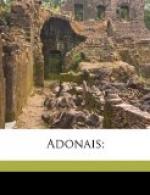It is also worth observing that the fragmentary poem of Shelley named Prince Athanase, written in 1817, was at first named Pandemos and Urania; and was intended, as Mrs. Shelley informs us, to embody the contrast between ‘the earthly and unworthy Venus,’ and the nobler ideal of love, the heaven-born or heaven-sent Venus. The poem would thus have borne a certain relation to Alastor, and also to Epipsychidion. The use of the name ‘Urania’ in this proposed title may help to confirm us in the belief that there is no reason why Shelley should not have used the same name in Adonais with the implied meaning of Aphrodite Urania.
On the whole I am strongly of opinion that the Urania of Adonais is Aphrodite, and not the Muse.
ADONAIS:
GENERAL EXPOSITION.
The consideration which, in the preceding section, we have bestowed upon the ‘Argument’ of Adonais will assist us not a little in grasping the full scope of the poem. It may be broadly divided into three currents of thought, or (as one might say) into three acts of passion. I. The sense of grievous loss in the death of John Keats the youthful and aspiring poet, cut short as he was approaching his prime; and the instinctive impulse to mourning and desolation. 2. The mythical or symbolic embodiment of the events in the laments of Urania and the Mountain Shepherds, and in the denunciation of the ruthless destroyer of the peace and life of Adonais. 3. The rejection of mourning as one-sided, ignorant, and a reversal of the true estimate of the facts; and a recognition of the eternal destiny of Keats in the world of mind, coupled with the yearning of Shelley to have done with the vain shows of things in this cycle of mortality, and to be at one with Keats in the mansions of the everlasting. Such is the evolution of this Elegy; from mourning to rapture: from a purblind consideration of deathly phenomena to the illumination of the individual spirit which contemplates the eternity of spirit as the universal substance.




